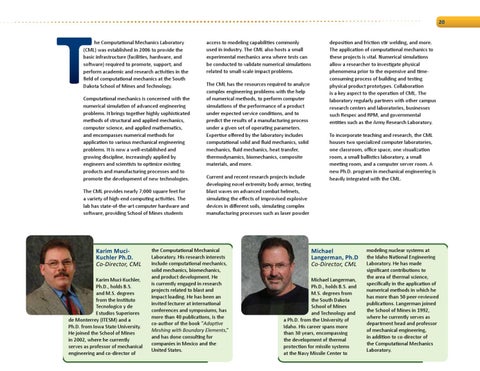20 he Computational Mechanics Laboratory (CML) was established in 2006 to provide the basic infrastructure (facilities, hardware, and software) required to promote, support, and perform academic and research activities in the field of computational mechanics at the South Dakota School of Mines and Technology. Computational mechanics is concerned with the numerical simulation of advanced engineering problems. It brings together highly sophisticated methods of structural and applied mechanics, computer science, and applied mathematics, and encompasses numerical methods for application to various mechanical engineering problems. It is now a well-established and growing discipline, increasingly applied by engineers and scientists to optimize existing products and manufacturing processes and to promote the development of new technologies. The CML provides nearly 7,000 square feet for a variety of high-end computing activities. The lab has state-of-the-art computer hardware and software, providing School of Mines students
Karim MuciKuchler Ph.D. Co-Director, CML Karim Muci-Kuchler, Ph.D., holds B.S. and M.S. degrees from the Instituto Tecnologico y de Estudios Superiores de Monterrey (ITESM) and a Ph.D. from Iowa State University. He joined the School of Mines in 2002, where he currently serves as professor of mechanical engineering and co-director of
access to modeling capabilities commonly used in industry. The CML also hosts a small experimental mechanics area where tests can be conducted to validate numerical simulations related to small-scale impact problems. The CML has the resources required to analyze complex engineering problems with the help of numerical methods, to perform computer simulations of the performance of a product under expected service conditions, and to predict the results of a manufacturing process under a given set of operating parameters. Expertise offered by the laboratory includes computational solid and fluid mechanics, solid mechanics, fluid mechanics, heat transfer, thermodynamics, biomechanics, composite materials, and more. Current and recent research projects include developing novel extremity body armor, testing blast waves on advanced combat helmets, simulating the effects of improvised explosive devices in different soils, simulating complex manufacturing processes such as laser powder
the Computational Mechanical Laboratory. His research interests include computational mechanics, solid mechanics, biomechanics, and product development. He is currently engaged in research projects related to blast and impact loading. He has been an invited lecturer at international conferences and symposiums, has more than 40 publications, is the co-author of the book “Adaptive Meshing with Boundary Elements,� and has done consulting for companies in Mexico and the United States.
deposition and friction stir welding, and more. The application of computational mechanics to these projects is vital. Numerical simulations allow a researcher to investigate physical phenomena prior to the expensive and timeconsuming process of building and testing physical product prototypes. Collaboration is a key aspect to the operation of CML. The laboratory regularly partners with other campus research centers and laboratories, businesses such Respec and RPM, and governmental entities such as the Army Research Laboratory. To incorporate teaching and research, the CML houses two specialized computer laboratories, one classroom, office space, one visualization room, a small ballistics laboratory, a small meeting room, and a computer server room. A new Ph.D. program in mechanical engineering is heavily integrated with the CML.
Michael Langerman, Ph.D Co-Director, CML Michael Langerman, Ph.D., holds B.S. and M.S. degrees from the South Dakota School of Mines and Technology and a Ph.D. from the University of Idaho. His career spans more than 30 years, encompassing the development of thermal protection for missile systems at the Navy Missile Center to
modeling nuclear systems at the Idaho National Engineering Laboratory. He has made significant contributions to the area of thermal science, specifically in the application of numerical methods in which he has more than 50 peer-reviewed publications. Langerman joined the School of Mines in 1992, where he currently serves as department head and professor of mechanical engineering, in addition to co-director of the Computational Mechanics Laboratory.
